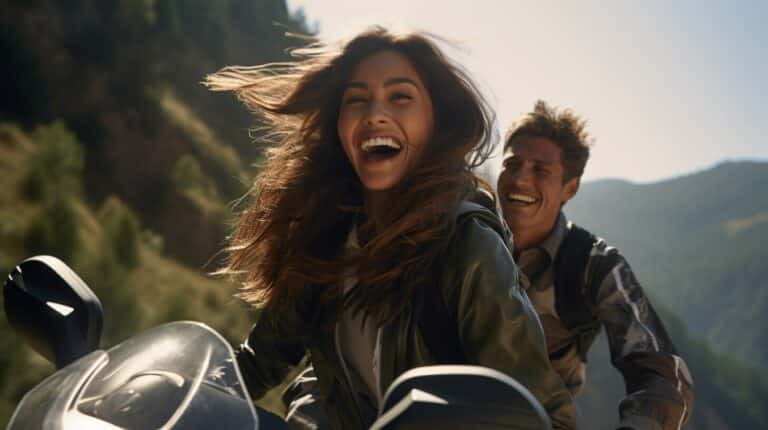Are you ready to embark on an exciting journey as a motorcycle passenger? Riding on the back of a motorcycle offers a thrilling and unique experience, but it also comes with important responsibilities. Ensuring the safety and enjoyment of both the passenger and the driver should be a top priority. By following some essential guidelines, you can have a memorable and safe time as a motorcycle passenger.
- Sit close to the driver and mirror their body language to maintain balance and stability.
- Wear appropriate protective gear, including a helmet, jacket, riding pants, boots, and gloves, for maximum safety.
- Avoid shifting or wiggling unexpectedly, as it can impact the bike’s balance and stability.
- Lean with the driver during turns and stops to maintain a stable position.
- Establish clear communication and trust with the rider for a smoother and safer ride.
Being a motorcycle passenger requires attentiveness, adherence to safety measures, and effective communication. By following these guidelines, you can enjoy the thrill of riding on the back of a motorcycle while ensuring a safe and enjoyable experience for everyone involved.
Understanding the Role of a Motorcycle Passenger
As a motorcycle passenger, your position and movements play a crucial role in maintaining the bike’s balance and ensuring a smooth ride. It is important to understand the dynamics between the passenger and the rider to ensure a safe and enjoyable journey.
When taking the passenger seat, sit close to the driver and place your hands on their waist or hold onto designated handholds if available. This helps establish a secure connection and allows you to anticipate the bike’s movements, making it easier to maintain balance.
| TIP | Always hold on securely to the rider or designated handholds. |
|---|
It is essential to mirror the body language of the driver. When they lean into a turn, lean with them smoothly and naturally. By doing so, you help distribute the weight evenly, promoting better handling and stability. Any sudden movements or shifting can impact the bike’s balance, so it’s important to avoid unnecessary wiggling or shifting while on the motorcycle.
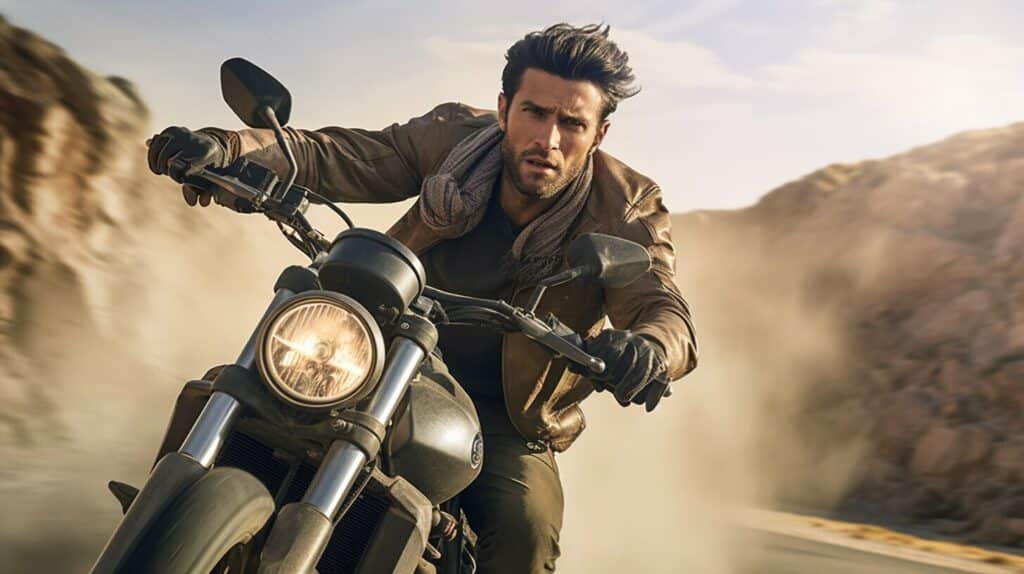
“Being a motorcycle passenger is all about trust and communication with the rider. By understanding your role and following the necessary safety measures, you can contribute to a safe and enjoyable ride for both of you.”
Passenger Positioning Guidelines:
- Sit close to the driver.
- Mirror the rider’s body language.
- Avoid sudden movements or shifting.
- Lean smoothly and naturally during turns.
By following these guidelines, you can enhance your riding experience and ensure a smoother, safer journey as a motorcycle passenger.
Essential Riding Gear for Motorcycle Passengers
Prioritizing your safety as a motorcycle passenger means investing in the right riding gear. Riding a motorcycle is an exhilarating experience, but it also comes with inherent risks. Wearing appropriate protective gear not only protects you from potential injuries but also enhances your overall riding experience.
One of the most crucial pieces of gear is a helmet. It is essential to choose a helmet that fits you properly and meets safety standards. A good helmet provides protection for your head in the event of a fall or collision. Remember, safety should never be compromised, so always wear a helmet that is designed for motorcycle use.
In addition to a helmet, a jacket is another important item to consider. A motorcycle jacket not only offers protection from the elements but also provides an additional layer of protection in case of an accident. Look for a jacket made from sturdy materials such as leather or durable textile fabrics. These jackets are designed to protect against abrasions and impacts.
When it comes to riding pants, it’s important to choose ones that are specifically designed for motorcycle riding. These pants typically feature reinforced areas to offer protection in case of a fall or slide. Riding pants are available in various styles, including jeans with built-in protective inserts. Remember, regular denim pants are not designed to provide the same level of protection as purpose-built riding pants.
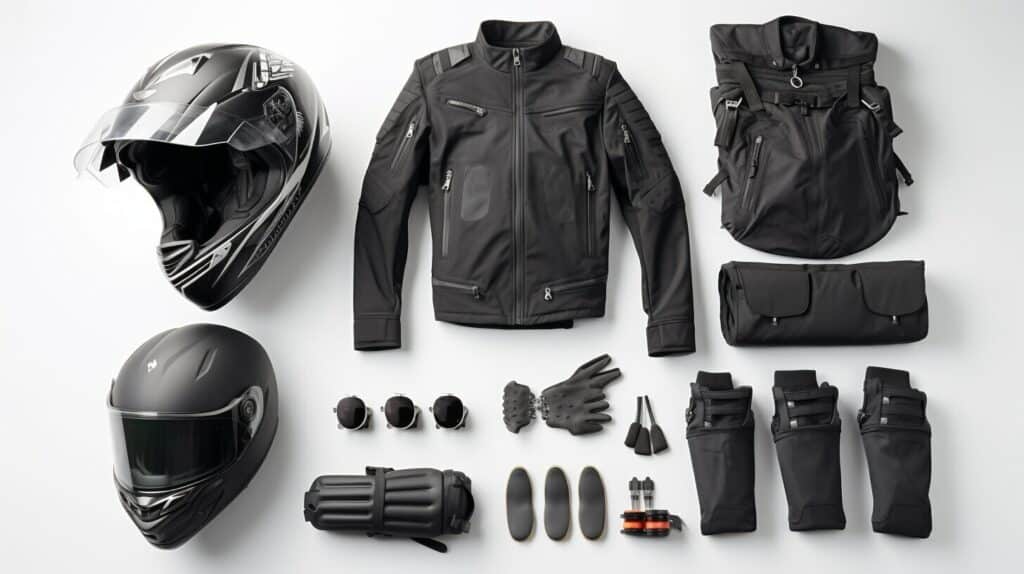
- Helmet: Ensure it fits properly and meets safety standards.
- Jacket: Look for sturdy materials like leather or durable textile fabrics.
- Riding Pants: Opt for purpose-built riding pants with reinforced areas.
- Boots: Choose sturdy boots with good ankle support.
- Gloves: Select gloves that provide finger and knuckle protection.
Remember, wearing the right gear is not just about complying with safety regulations; it’s about protecting yourself and enhancing your riding experience. By investing in appropriate gear, you can ride with confidence and peace of mind, knowing that you have taken the necessary precautions to keep yourself safe on the road.
| Gear | Importance |
|---|---|
| Helmet | Protects the head in case of accidents or falls. |
| Jacket | Provides protection from the elements and additional safety in case of an accident. |
| Riding Pants | Offers reinforced areas to protect against falls or slides. |
| Boots | Provide ankle support and stability while riding. |
| Gloves | Protects fingers and knuckles from abrasions and impacts. |
Riding Techniques for Motorcycle Passengers
To ensure a comfortable and balanced ride, motorcycle passengers should adopt specific riding techniques. By following these practices, passengers can contribute to the overall safety and enjoyment of the journey. Whether you’re riding on touring bikes or cruising on a smaller motorcycle, these techniques apply to all passengers.
One important aspect of being a motorcycle passenger is understanding how to use the passenger foot pegs effectively. These pegs provide support and stability, allowing passengers to maintain a proper seated position. By placing your feet on the foot pegs and ensuring they are securely in place, you can help to distribute your weight evenly and provide balance for the bike.
Additionally, it is essential for passengers to position their bodies close to the driver. This helps in mirroring the driver’s body movements and allows for better communication and coordination. By staying in sync with the driver’s body position during turns and stops, passengers can help maintain the bike’s stability and ensure a smoother ride.
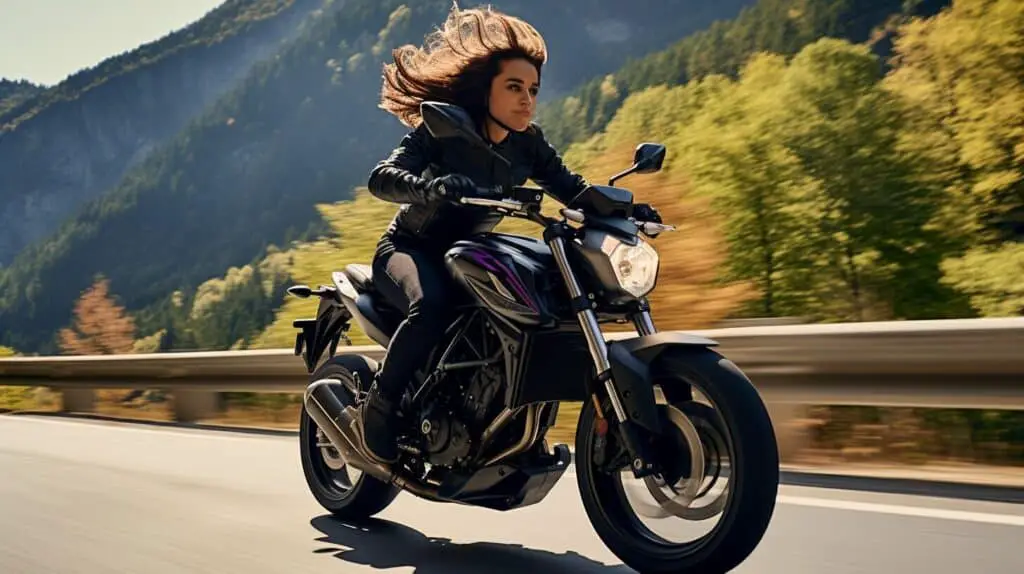
Furthermore, leaning with the driver is another fundamental technique for motorcycle passengers. Leaning in the same direction as the driver during turns helps maintain the bike’s balance and stability. It is important to lean naturally and smoothly, avoiding sudden shifts in weight that can affect the bike’s handling.
Remember, clear communication and trust between the passenger and the driver are crucial. Establishing hand signals or predetermined communication methods can enhance safety and minimize misunderstandings. By following these riding techniques, motorcycle passengers can have a more enjoyable and secure experience on the road.
Table: Essential Riding Techniques for Motorcycle Passengers
| Riding Technique | Description |
|---|---|
| Utilize Passenger Foot Pegs | Place feet securely on the foot pegs to distribute weight evenly and provide balance. |
| Sit Close to the Driver | Mirror the driver’s body movements for better communication and coordination. |
| Lean with the Driver | During turns, lean naturally in the same direction as the driver to maintain balance. |
| Establish Communication | Use hand signals or predetermined communication methods for clear and effective communication. |
Communication and Trust between Passenger and Rider
Effective communication and trust are key components of a successful motorcycle passenger experience. As a passenger, it is important to establish clear communication channels with the rider to ensure a smooth and safe ride. One effective way to communicate is through hand signals. Agree on simple hand signals before the ride, such as a thumbs-up for “good to go” or a tap on the shoulder for a quick stop. By using these signals, you can convey important messages without the need for verbal communication, which can be difficult due to the noise of the engine.
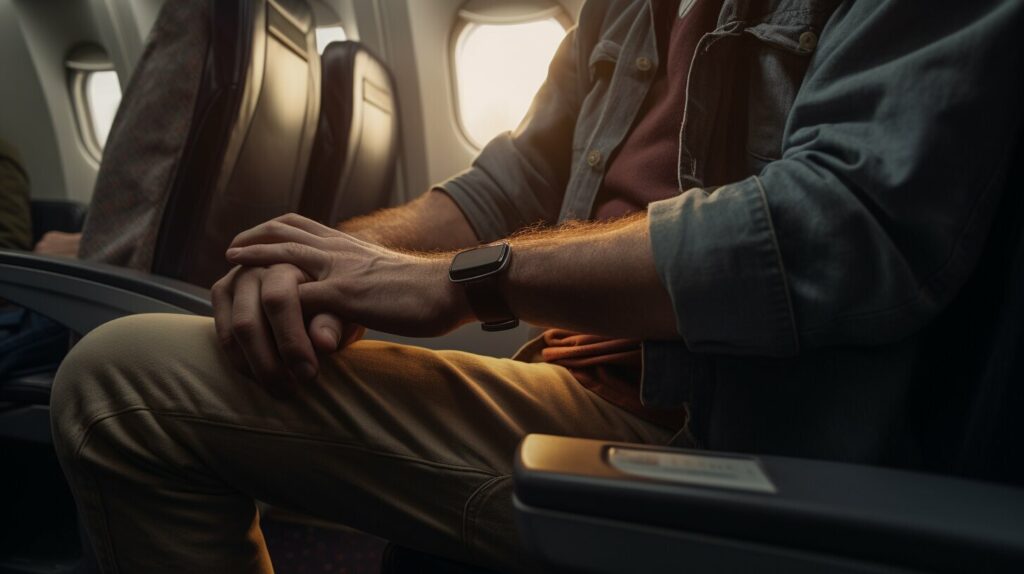
Trust is equally important as it allows both the passenger and the rider to feel comfortable and confident during the ride. As a passenger, avoid sudden movements or shifting too much, as it can make the rider uncomfortable and affect the bike’s balance. Instead, try to mirror the rider’s body language and movements to create a sense of unity and stability. By maintaining a stable position and following the rider’s lead, you can contribute to the overall safety and enjoyment of the ride.
Remember that being a motorcycle passenger is a shared experience, and both parties should prioritize open communication and trust. By establishing a strong foundation of communication and trust, you can create a memorable and enjoyable ride for everyone involved.
Situational Awareness and Preparedness
Being aware of your surroundings and prepared for various riding scenarios is vital as a motorcycle passenger. This includes anticipating sudden movements, navigating turns and stops, and maintaining a stable position throughout the ride. By understanding these key aspects, you can contribute to a safer and more enjoyable experience for both you and the driver.
When riding as a passenger, it’s important to be mindful of sudden movements. Avoid shifting or wiggling unexpectedly, as this can affect the bike’s balance and stability. Instead, maintain a steady and stable position, mirroring the driver’s body movements. By doing so, you can enhance the overall balance of the motorcycle and make the ride more comfortable for both you and the driver.
Turns and stops are common maneuvers during motorcycle rides. As a passenger, it’s crucial to lean with the driver, especially when taking corners or making sudden stops. This helps distribute the added weight evenly, allowing for better control and maneuverability. By leaning in sync with the driver, you contribute to the bike’s stability and minimize the chances of any sudden jerks or imbalances.
To aid in situational awareness, maintaining clear communication channels with the driver is vital. This can include using hand signals or predetermined gestures to indicate any discomfort or need for adjustments. Open and honest communication fosters trust, ensuring that both the passenger and the driver are on the same page and can respond effectively to any challenges that may arise.

| Situational Awareness Tips | Preparedness Tips |
|---|---|
|
|
Tips for Enjoyable Motorcycle Passenger Experiences
By following these tips, you can enhance your motorcycle passenger experience and make the most of each ride. One of the first things to consider is dressing appropriately. This means wearing long pants to protect against hot exhaust pipes and a denim jacket for added protection. Don’t forget to wear leather gloves and solid shoes or boots to ensure a comfortable and safe ride. Tennis shoes are not recommended as they may not provide adequate protection.
When it comes to riding, it’s important to communicate and establish trust with the driver. Use clear hand signals to indicate any discomfort or upcoming stops. Remember to sit close to the driver and mirror their body position to maintain balance and stability. Avoid sudden movements that can affect the bike’s balance and be mindful of the driver’s comfort throughout the entire ride.
Being prepared for turns and stops is crucial for a smooth ride. Lean with the driver during turns and maintain a stable position to prevent any shifts in weight. This will help ensure both your safety and the overall stability of the motorcycle. Additionally, being aware of the bike’s movements and anticipating sudden movements will help you remain in control as a passenger.
| Tips for Enjoyable Motorcycle Passenger Experiences |
|---|
| 1. Dress appropriately: Wear long pants, a denim jacket, leather gloves, and solid shoes or boots for maximum protection. |
| 2. Communicate and trust: Use hand signals to communicate with the driver and establish trust for a smoother ride. |
| 3. Be prepared for turns and stops: Lean with the driver and maintain a stable position to ensure balance and stability. |
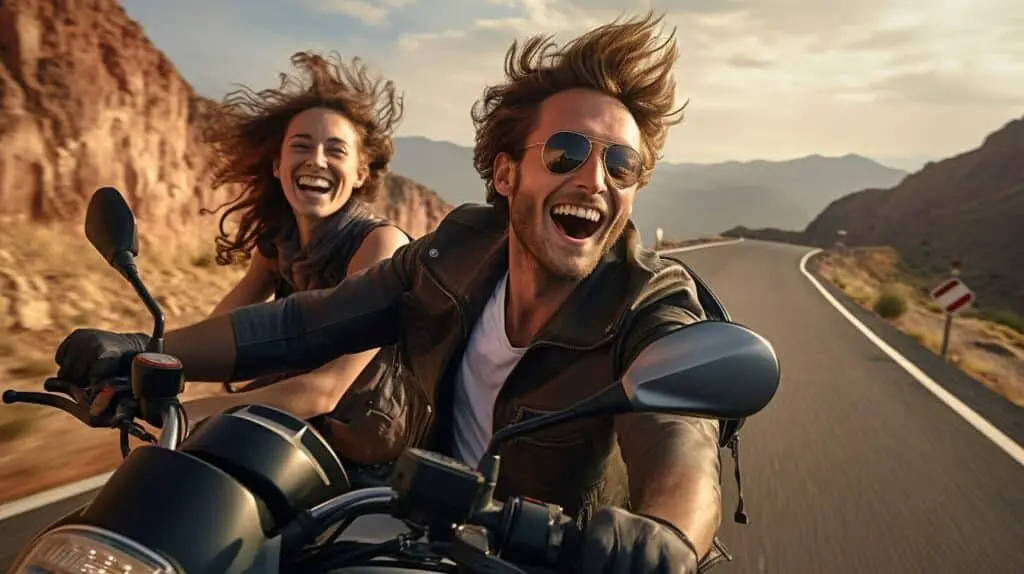
By keeping these tips in mind, you can have an enjoyable and safe motorcycle passenger experience. Remember to always prioritize safety and communication with the driver. So gear up, hold on tight, and get ready to embark on exciting journeys as a motorcycle passenger!
Safety Checks and Precautions for Motorcycle Passengers
Prioritizing safety as a motorcycle passenger involves performing essential safety checks and taking necessary precautions. Being a good passenger means understanding the importance of maintaining balance and stability while on the back of a motorcycle. Here are some key safety checks and precautions to keep in mind:
Roll Off Test:
Before setting off on your motorcycle journey, it is crucial to perform a roll off test. This involves gently pushing the bike forward while keeping your feet on the ground. Observe how the bike responds to the added weight of a passenger. Ensure that the bike makes a smooth start without any wobbling or imbalance. If any issues arise during this test, communicate with the rider and address the problem before continuing the ride.
Added Weight Considerations:
Remember that as a passenger, your presence adds weight to the motorcycle. Be mindful of this and avoid sudden movements that can disrupt the bike’s balance. Sit close to the driver, leaning forward slightly, and mirror their body movements to maintain stability. This will help the bike respond smoothly to turns and stops.
Being a Considerate Passenger:
During your first ride as a passenger, prioritize communication and establish trust with the rider. Use hand signals to convey any discomfort or need for adjustment. Avoid making sudden movements or shifting positions without giving the rider a heads-up. By being a considerate and communicative passenger, you contribute to a safer and more enjoyable experience for both yourself and the driver.
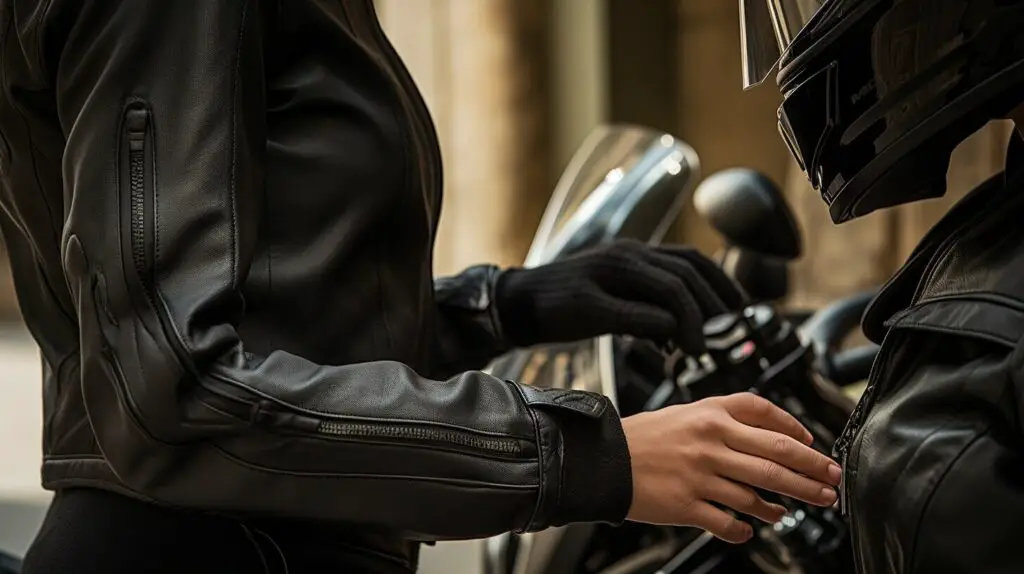
| Safety Checklist | Precautions |
|---|---|
| Perform roll off test before the ride | Do not make sudden movements |
| Avoid disrupting bike’s balance | Lean forward and mirror the rider’s body movements |
| Communicate discomfort or adjustments needed | Establish trust with the rider |
By following these safety checks and precautions, you can ensure a smoother and safer ride as a motorcycle passenger. Remember that communication, trust, and being a responsible passenger play a vital role in creating a positive experience for both yourself and the rider.
Conclusion
Being a motorcycle passenger can be an exhilarating experience, but it comes with responsibilities to ensure the safety of both you and the rider. As a passenger, it’s important to understand that your positioning and movements can affect the balance and handling of the bike. By sitting close to the driver and mirroring their body language, you can help maintain stability and a smoother ride.
Wearing appropriate protective gear is crucial for your safety. Make sure to wear a helmet, jacket, riding pants, boots, and gloves to protect yourself from any potential accidents or injuries. Dressing appropriately can also make the ride more comfortable, especially in situations where hot exhaust pipes may be present. Remember to wear long pants, a denim jacket, leather gloves, and solid shoes to ensure maximum protection.
Communication and trust between the passenger and the driver are key for a safe and enjoyable ride. Establish clear communication channels, such as using hand signals, to convey any necessary information to the rider. Avoid sudden movements or shifting that can catch the driver off guard. By working together and building trust, you can enhance the overall experience for both parties.
Lastly, it’s important to be prepared and aware of your surroundings. Anticipate the bike’s movements during turns and stops by leaning with the driver and maintaining a stable position. Being alert and attentive to the road ahead can help you adapt to any unexpected situations. Remember, being a good passenger is not only about enjoying the ride but also about contributing to a safe and enjoyable journey for everyone involved.
FAQ
Q: What are the responsibilities of a motorcycle passenger?
A: As a motorcycle passenger, it is important to sit close to the driver, mirroring their body language, and holding on securely.
Q: What protective gear should a motorcycle passenger wear?
A: A motorcycle passenger should wear appropriate protective gear, including a helmet, jacket, riding pants, boots, and gloves.
Q: Why is it important for a passenger to avoid shifting or wiggling unexpectedly?
A: Shifting or wiggling unexpectedly can affect the balance of the motorcycle, so it is important for passengers to maintain a stable position.
Q: How should a passenger prepare for turns and stops?
A: Passengers should lean with the driver and maintain a stable position to effectively navigate turns and stops.
Q: What role does communication play between the passenger and the driver?
A: Communication and trust between the passenger and the driver are essential for a smooth and safe ride on a motorcycle.

